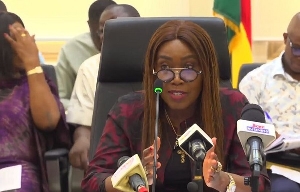General News of Monday, 29 March 2021
Source: goldstreetbusiness.com
How Ghana’s coronavirus fiscal response compares with the rest of the world
Since the 2021 budget proposals were unveiled to Parliament a fortnight ago, debate has raged over government’s plans to bring the fiscal deficit back under heel. Various stakeholder groups, ranging from organized labour, to the banking industry are accusing government of effectively trying to recoup the resources it spent on supporting households and enterprises last year at the height of socio economic restrictions necessarily imposed to curb the spread of COVID-19 infections.
Government itself has responded by explaining that the new taxes and levies it its proposing are simply an attempt to share the economic burden of keeping the economy afloat during the ongoing era of COVID-19 fiscal disruptions, havin g realized that it cannot afford to do it alone.
Unsurprisingly, the political opposition is asserting that Ghana’s current fiscal predicament is the result of poor macro-economic management rather than the inescapable impacts of COVID-19.
In an effort to discern which position is correct, GOLDSTREET BUSINESS juxtaposes the results of Ghana’s economic policies aimed at curtailing the adverse effects of the pandemic against those generated across the rest of the world, using the World Bank’s latest global Fiscal Monitor report to establish baseline averages for the various categories of sovereign national economies as classified into advanced, middle income (emerging markets) and low income economies by the Bank.
Curiously, the World Bank – maybe inadvertently – includes Ghana in its low income economy classification at some point, despite Ghana being officially classified as a (lower) middle income emerging market economy since 2010 when the first of two economic rebasing exercises conducted over the past decade resulted in a per capita income level that puts it in that classification. To play safe we have compared Ghana’s economic circumstances, resulting from the impact of COVID-19 and the consequent economic management policies against global averages for both middle income and low-income countries.
Hereunder are the relevant parts of the Fiscal Monitor report interspersed with the specific data and circumstances for Ghana which we have published in italics and which are not part of the World Bank report itself.
Government Support Is Vital as Countries Race to Vaccinate
A Differentiated Fiscal Policy Landscape
The COVID-19 pandemic has posed a severe challenge to public finances. The contraction in output and ensuing fall in revenues, along with emergency lifelines, boosted government deficits and debts beyond levels recorded during the global financial crisis.
Global fiscal support reached nearly US$14 trillion, comprising US$7. 8 trillion in additional spending or forgone revenue and US$6 trillion in equity injections, loans, and guarantees—an additional US$2.2 trillion compared with the October 2020 Fiscal Monitor. The scale and form of such support varied depending on the impact of shocks, access to low-cost borrowing, and pre-crisis fiscal conditions.
As a result, global public debt approached 98 percent of GDP. Advanced economies recorded the largest increases in deficits and debt, followed by emerging market and middle-income economies and low-income developing countries.
In advanced economies, higher deficits reflect roughly equal increases in spending and declines in revenues, whereas in emerging market and middle-income economies and low-income developing countries, on average, the rise in deficits stems largely from the collapse in revenues caused by lower economic activity.
The Fiscal Monitor Update at a Glance
•Global fiscal support of $14 trillion has contributed to saving lives and livelihoods and has mitigated the effects of the pandemic on consumption and output. Together with economic contraction causing lower revenues, such support has led to a rise in public debt and deficits.
•Global public debt is estimated to reach 98 percent of GDP at the end of 2020, compared with 84 percent for the same date based on projections in the October 2019 Fiscal Monitor.
•Fiscal responses have been shaped by access to financing: average overall deficits as a share of GDP in 2020 are projected at –13.3 percent for advanced economies, –10.3 percent for emerging market and middle-income economies, and –5.7 percent for low-income developing countries.
•Global cooperation on access to treatments and vaccines is essential. Fiscal support to vulnerable households and firms needs to be available as appropriate until the recovery is firmly underway.
•Fiscal policy should support sustainable recovery and facilitate the transformation to a green, digital, and inclusive economy while managing fiscal and financing risks.
•Credible medium-term fiscal frameworks are needed now, especially where debt is high and financing conditions are tight or at risk. Many countries are providing additional fiscal support to households and firms, given the resurgence of infections and reimposition of restrictions in some regions, while remaining flexible and attuned to economic developments. Since the October 2020 Fiscal Monitor, several governments have announced new fiscal actions or have extended the previous temporary measures (Australia, Canada, France,Germany, India, Indonesia, Japan, Spain, United Kingdom, United States). Others are contemplating new legislation (some euro area member countries). Meanwhile, multiyear fiscal measures in some countries have allowed for flexibility on the timing and size of short-term support conditional on the evolution of the pandemic and its economic and social impact (Canada) while facilitating the post–COVID-19 recovery by identifying policy priorities such as green investment, digitalization, and reductions in inequality and poverty (Canada, EU member states, Japan).
Most countries are projected to experience lower fiscal deficits in 2021 as revenues rise and expenditures decline automatically with the recovery and temporary pandemic-related measures expire. However, without additional fiscal support beyond that included in 2021 budgetary plans, projected fiscal contractions this year could slow the recovery, whose pace and extent remain uncertain. Reflecting elevated debt levels, exchange rate risks, and concerns about rating downgrades and adverse market reactions if large deficits persist, many emerging market and developing economies are expected to tighten fiscal policy in 2021 Under the current projections, countries with elevated public debt and financing constraints will implement larger fiscal adjustments over the medium term.
Fiscal Developments and Outlook, by Country Income Group Advanced Economies:
Unprecedented Fiscal Expansion and Continued Support
In 2020, almost all advanced economies offered large fiscal support to counter the health crisis and its economic fallout, totaling $ 11 .8 trillion. The average cyclically adjusted primary deficit1 jumped to 9.6 percent of potential GDP because most on-budget measures manifested as additional spending, the average total expenditure of advanced economies increased substantially, particularly social spending. Revenues fell as a result of lower economic activity and decreased even more sharply than GDP as people and firms struggled to meet their tax obligations and as tax relief was provided.
In recent months, several countries have announced medium-term fiscal plans and have provided additional support to safeguard the recovery and limit the risk of scarring. In the United States, assistance of 14.8 percent of GDP was provided to households, firms, and state and local governments in March and April, and a new federal fiscal stimulus package of 4.3 percent of GDP was enacted in December.
Japan and Korea announced new plans to increase spending on green investment and digitalization, and Japan has extended some existing programs amid a third wave of infections; policies in the United Kingdom have evolved alongside pandemic developments, with recent decisions to enhance and extend measures, such as the job retention scheme, into 2021. Similarly, EU leaders have agreed on the Next Generation EU recovery package, including green investment and digitalization. Moreover, the European Union moved quickly to support countries by activating the escape clause in the fiscal rules and temporarily allowing state aid to firms.
With severe economic contraction and massive fiscal support, the average general government gross-debt-to -GDP ratio soared to 123 percent in 2020. For three-quarters of advanced economies, the fiscal deficit in 2021 is expected to shrink, as pandemic-related support expires or winds down and automatic stabilizers play out (for example, lower unemployment benefits and higher tax revenues). Despite new support measures, the fiscal stance in the United States is projected to tighten in 2021 amid weakness in the job market and record COVID-19 fatalities. In the United Kingdom, the planned unwinding of the emergency responses could result in a fiscal drag in 2021 even with the new multiyear package.
Several countries have introduced new measures in their 2021 budgets to mitigate the effects of the pandemic as vaccines are distributed in coming months. For example, Canada committed to an additional $70–100 billion stimulus (3–4 percent of GDP) over the next three years, with the size and timing dependent on the pandemic path. In Greece, certain pandemic-related measures have been extended; and new measures have been introduced—including solidarity taxes and social security contributions—to support the recovery. Australia introduced a “JobMaker” plan in the fiscal year (FY) 2021 budget, with additional stimulus measures during FYs 2021–24, including credits for hiring, full investment expensing, and income tax cuts. In New Zealand, fiscal support in 2021 includes business tax loss carryback and infrastructure investment. Considering the scaling back of pandemic-related measures and given the projected recovery, public debt, on average, is expected to rise modestly in 2021 and stabilize over the medium term. While uncertainty is unusually high, large primary fiscal deficits are projected to be offset by favorable interest-growth differentials as debt service costs continue to fall and economies grow.
Even so, debt ratios are projected to remain well above pre–COVID-19 levels in a majority of countries over the medium term, with some recording rising ratios to accommodate pension and health spending pressures related to aging, and to scale up infrastructure investment (United States).
Emerging Market and Middle-Income Economies: Differentiated Fiscal Responses
Almost 90 percent of countries in this group eased fiscal policy in 2020 to contain the health crisis and support the economy, with the overall fiscal deficit widening by 5.5 percentage points to reach 10.3 percent of GDP. (Ghana’s was significantly higher at 11.7 percent.) Across emerging market and middle-income economies, China shifted to broader demand support over time as it brought the pandemic under control early. India recently announced a new support package including multiyear investment incentives, additional agricultural subsidies, and measures to support housing as well as formal and rural employment. Brazil expanded the social safety net and provided a job retention program.
Double-digit deficits in 2020 have contributed to an estimated surge in average government debt ratios to 63.3 percent of GDP. (Ghana’s is again higher at 67.4 percent.) The sharp rise in government debt was driven largely by the severe economic contraction and—for commodity exporters—lower revenues from commodities. Central banks’ asset purchases and other support measures at the global level helped reduce average long-term bond yields by 0.5 percentage point in this group, to below 4 percent, with effective interest rates declining in more than half of countries. (In Ghana while short and medium term cedi-denominated bonds similarly fell, long term bond yields initially rose but have been falling since the last quarter of 2020. However, throughout 2020 long term bond yields exceeded 18 percent which is four and a half times the 4 percent average for middle income emerging market economies.)
Vulnerabilities remain to rollover risks or to procyclical fiscal tightening from a potential reversal in investor appetite—large financing needs, foreign currency denomination, and short maturity can be amplifying factors.
If the health crisis abates and output recovers as in the January World Economic Outlook Update baseline, the average overall deficit is set to narrow modestly in 2021 to 8.6 percent of GDP. (Ghana is targeting a higher 9.5 percent for 2021.) Under that scenario, revenues are expected to recover modestly, and pandemic-related spending is set to decline gradually, despite significant variation across countries. China envisages greater support to households to stimulate consumption and facilitate rebalancing. Russia foresees a reduction in non-oil deficits by gradually unwinding the pandemic-related fiscal measures, with the aim of returning to fiscal rules in 2022. (Ghana is targeting a return to its 5 percent fiscal deficit rule by 2023. South Africa plans to reprioritize expenditures away from goods and services and investment projects to additional temporary spending on social grants, unemployment benefits, and health expenditure. Indonesia’s 2021 budget envisages a moderate deficit reduction, reflecting the partial unwinding of exceptional fiscal measures while prioritizing health spending, social protection, and public investment. Mexico recently approved a “no policy change” conservative budget, risking a weaker recovery. In Brazil, the expiration of the “war budget” by the end of 2020 and a return to the constitutional expenditure ceiling imply an abrupt tightening of primary expenditures.
The average government debt for this group is projected to rise further in 2021 and remain on an upward trajectory (driven largely by China). Although the average interest-growth differential is expected to remain favourable, sizable primary deficits continue to weigh on debt, which is expected to rise further in two-thirds of emerging market and middle-income economies in 2021. (Ghana is targeting a reduction in its primary balance deficit in 2021 to 1.3 percent of GDP in 2021 anmd a positive primary balance from 2022.) General government debt in China is expected to reach 69 percent of GDP in 2021, higher than the emerging market average. Likewise, in South Africa, the pandemic-related increase in debt is not expected to stabilize in 2021. (Ghana expects to stabilize its nominal debt from 2022 but begin reducing its debt to GDP ratio from 2021 although the World Bank does not expect this to happen.)
Even for countries with stable debt ratios in 2021, vulnerabilities remain high. In Brazil, despite the sharp fiscal withdrawal in 2021, financing needs are sizable, and gross public debt is projected at 92 percent of GDP. India’s government debt is expected to remain elevated, at 83 percent of GDP, highlighting the need for a credible medium-term fiscal framework to enhance confidence, anchored on revised fiscal objectives and revenue mobilization.
Low-Income Developing Countries: Formidable Trade-Offs
Policy options in response to the pandemic have been more limited in low-income developing countries, owing to financing constraints and less developed welfare programs. Notwithstanding shorter lockdown periods and less severe economic contractions, spending needs are sizable both to respond to the pandemic and to meet the United Nations Sustainable Development Goals. However, revenue shortfalls from output drops and a concurrent fall in commodity prices, combined with debt vulnerabilities, have forced many low-income developing countries to limit the size of fiscal support.
The pandemic thus risks leaving a lasting impact, including higher poverty and malnutrition.
The average overall fiscal balance is estimated to be lower in 2020 by 1.7 percentage points of GDP, and the average public debt increased by 5 .2 percentage points to 48.5 percent of GDP at the end-2020. Even after accounting for higher external grants and exceptional emergency and concessional financing in many countries (including from the IMF), average revenues fell sharply.
Expenditures continued to rise in real terms, notably in health spending, and social assistance to vulnerable households. Many governments reprioritized spending—for example, by cutting capital expenditures. (In Ghana capital expenditure increased in 2020 from the previous three years, although it should be noted that capital expenditure in those three years was unusually low because government was focusing on fiscal consolidation. The situation changed in 2020 because government was not under pressure to engage in fiscal consolidation because of the peculiar circumstances created by COVID 19 and it took advantage of this to increase capital expenditure along with increased social intervention spending because it was an election year.
In 2021, the average fiscal deficit is projected to decline to 5 percent of GDP from 5.7 percent in 2020. (Ghana’s is expected to fall to 9.5 percent in 2021 from 11.7 percent in 2020.) As economies recover, revenue collection is projected to improve, whereas pandemic-related spending is projected to decline. Capital spending in 2021 is expected to recover partially in most countries after the temporary cuts in 2020 (Guinea, Haiti, Malawi, Nigeria, Tajikistan). However, deficits are expected to widen in a few countries as revenue-to -GDP ratios only partially recover, while spending and debt service costs are rising (Chad, Kenya, Myanmar). Although prospects for market financing are improving in some frontier market economies, near-term debt vulnerabilities remain high in many countries.
Financing large deficits remains challenging, given limited market access and restricted ability to increase revenues in the near term. Average debt levels are projected to peak in 2021, with debt service relative to tax revenues exceeding 20 percent in Ghana, (Ghana expects to spend 49.5 percent of its tax revenues on debt servicing in 2021) Kenya, Myanmar, Nigeria, and Zambia and an upward debt trajectory in some, especially oil-exporting countries, such as Nigeria. Actions were taken to provide grants, concessional loans, and debt relief to address a steep rise in public debt of low-income developing countries in 2020, including the 38 countries (out of 70) assessed to be “ at high risk” of or in debt distress, according to the IMF–World Bank Debt Sustainability Assessments. Fiscal adjustments in several countries (Ethiopia, Vietnam) and debt restructuring (Chad, Republic of Congo) are expected to contribute to debt reduction. As of the end of December 2020, 45 countries, or more than 60 percent of eligible countries, had formally requested to join or extend the Debt Service Suspension Initiative, benefiting from suspension of US$5 billion total debt service as reported by the G20 economies for May–December 2020. (Ghana declined to take advantage of this offer ostensibly because it would have disallowed it from doing a Eurobond issuance. While Ghana would have saved some US$500 million in suspended debt servicing payments this is barely one-tenth of the US$5billion in Eurobonds it plans to issue imminently.
Policy Priorities to Support a Durable Recovery
The strength of the recovery hinges on the control of the pandemic and the continuation of well-designed policy support tailored to country circumstances. Global cooperation on producing and widely distributing treatments and vaccines is crucial. Budget needs are expected to remain sizable, including for vaccine deployment; continued provision of emergency lifelines where local transmission remains high, including transfers to displaced households and otherwise viable firms; and broad-based demand support, where appropriate, as economies emerge from the pandemic amid a disproportionate adverse impact on the poor, women, and informal workers. This will pose formidable trade-offs for policymakers—especially in highly indebted emerging market and developing economies that face tight financing constraints and limited capacity to support those most affected by the crisis.
Fiscal support—essential for households, firms, and the recovery—needs to be maintained but tailored to the evolution of the pandemic and the economy, and should facilitate the necessary structural transformation. Emergency lifelines should only be rolled back gradually where local transmission has been low and activity has begun to normalize by reducing the coverage and generosity of programs. In those countries, further measures should be deployed to support the recovery as needed. Should the upside scenario of the World Economic Outlook Update materialize, lifelines could be phased out sooner.
Global fiscal support has mitigated the effects of the pandemic. Such support measures, however, should be better targeted by focusing on the most vulnerable households (see April 2020 Fiscal Monitor for policy options) and viable or strategic and systemic firms, and on helping workers prepare for a structurally transformed economy after the pandemic is under control (for example, through vocational training and hiring incentives).
Some economies that will continue to face difficult policy trade-offs even after reprioritizing noncritical spending and enhancing efficiency (including through better budget execution and control) will need additional assistance, including through extension of the Debt Service Suspension Initiative, grants, and concessional and emergency financing. Some emerging market and developing economies may be forced to ask for restructuring of their commercial and bilateral debt. Quick operationalization of the common framework for countries that need debt treatments and efforts to widen its coverage of eligible country debtors will be essential. Although effective vaccines offer hope, including by improving financing conditions for some emerging market and developing countries, policies should respond quickly to changes in conditions. If pandemic and economic indicators weaken, withdrawal of support to hard-hit people and firms should be halted or reversed while improving targeting. Temporary and targeted measures may need to be extended, with contingent spending plans developed for adverse situations. These can provide additional support through supplementary budgets, established COVID-19 funds for contingency while ensuring transparency in usage, and supportive funding from bilateral and multilateral assistance.
Fiscal policy needs to focus on enabling a green, digital, and inclusive transformation of the economy. Facilitating the reallocation of labour and capital through, for example, targeted time-bound and state-contingent hiring subsidies, wage-loss insurance programs, and enhanced training and job search programs is essential. A synchronized public investment push by economies with fiscal space would boost growth and generate positive spillovers. (Since Ghana does not have the requisite fiscal space it is executing a special GHc100 billion investment initiative called Ghana CARES, started in 2020 and concluding in 2023, but in which government will only provide GHc30 billion withy GHc70 billion to come from the private sector.) Strengthening transparency and governance practices remains crucial to reaping the full benefits of fiscal support.
Priorities include investing in climate change mitigation and adaptation, as well as digitalization—crowding in private investment. Strengthening social protection systems by improving the coverage and adequacy of benefits and enhancing efficiency (for example, by reducing program fragmentation and beneficiary overlaps) would help to counter the rise of inequality and poverty (April 2020Fiscal Monitor).
Addressing weaknesses in tax systems—including domestic measures and reforming international taxation—would support inclusive growth, through broader bases, (Government has over the past couple of years established a workable framework which will bring the vast informal sector into the income tax net for the very first time, and execution will begin this year) more progressive personal income taxation, more neutral capital taxation, improved VAT design, greater use of carbon, property, and inheritance taxes, and digital enhancements in revenue administration. Public debt jumped up as a result of the crisis and will keep vulnerabilities elevated. Balancing short-term demand support for the recovery with medium-term sustainability is critical. Credible medium-term fiscal frameworks and calibrated consolidation strategies need to be developed, especially in high-debt countries, supported by pro-growth and inclusive measures. (Ghana has designed a credible, comprehensive three year programme for recovering the economy from COVID 19 and putting it on a sustainable growth path by, in part by taking advantage of some of the opportunities created by the pandemic and the economic circumstances it brought with it.) Early announcement of such packages could create near-term space for manoeuvre.
A key element of such strategies will be tax reforms to promote inclusive growth. Governments will also need to monitor and manage fiscal risks (for example contingent liabilities from off-budget emergency measures), which, if realized, would further add to public debt.












